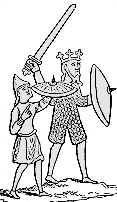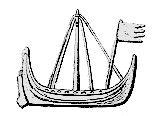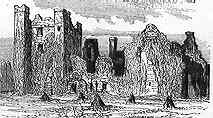 |
|
Vernacular
Languages |
|
The
use of vernacular
languages for the written word had something of a fluctuating history,
with a general tendency to increase towards the later part of the middle
ages. Languages are the most powerful symbol of ethnic identity. The encouragement
or repression of vernacular literacy has tended to coincide with the expression
or suppression of national or ethnic boundaries. |
|
The
use of vernacular languages in written works of any type cannot be divorced
from events and politics. The adoption of forms of Roman civilisation
by the Ostrogoth conquerors of Rome resulted in the production of Bibles
and other Christian texts using the Gothic
language. These are now mainly known only from palimpsests. |
|
Literacy
was re-established in Anglo-Saxon society through the church and was therefore
grounded in Latin. However, a cultural and ethnic revival in the 9th century
under the influence of Alfred the Great resulted in the production of
works in Old English.
These included Biblical texts, histories and religious commentaries and
were, in fact, Latin works translated into English rather than a recording
of the cultural heritage of English oral tradition. The famous manuscript
of Beowulf, an epic saga from oral tradition, is in fact known from only one copy produced probably
hundreds of years after the composition of the tale. |
 |
|
Beginning
of the preface to St Gregory's Pastoral Care in Old English
(Bodleian Library, Hatton MS 20, f.1) with reference to Aelfred
kyning. |
 |
The Anglo-Saxon Chronicle is a historical
text in Old English chronicling events in England up to and shortly after
the Norman Conquest. There are several copies in slightly variant versions,
varying mainly in the additions at the end of the time period. This can
be seen as an attempt to transform an oral tradition into a literary format;
the new beginnings of literary history.
|
|
The
use of Old English in literary or religious works largely ceased after
the Norman Conquest. The later Anglo-Saxon kings had issued writs
in the vernacular. After the Conquest, royal charters
were occasionally issued in bilingual form, duplicated in Latin and Old
English. Each language was written in its own particular script.
Less solemn legal transactions may sometimes be found in the vernacular.
Vernacular terms were also included in Latin charters to describes rights
or privileges known in Anglo-Saxon law. |
|
|
 |
|
In
a Latin charter of Henry I to Westminster Abbey (Westminster Abbey Muniments
No.XXXI). |
|
The rights and privileges which were confirmed in the example above included
infangenetheof and flemenefyrmthe among other Old English mysteries. |
|
England
was, of course, linguistically divided at this time. English was the language
of the lower classes and of the conquered, while Anglo-Norman
or Norman French was the language of the conquerors and those who wished
to be counted as the aristocracy. Anglo-Norman is rarely encountered in
formal documents, although it can be found in Parliament Rolls,
Privy Seal documents
and private correspondence predating the 15th century, as well as in some
historical works. |
|
Scandinavian
vernacular saga texts were also only recorded in manuscript form centuries
after their composition. In areas peripheral to the establishment of literate
Latin based engines for the main motivating forces of society, such as
Iceland, manuscripts with many formal qualities in common with those of
mainland Europe recorded sagas from oral tradition in the late middle
ages and into the 17th century. |
 |
|
Irish
was also written as a vernacular language in the earlier medieval period.
The existence of secular schools of versecraft, historical and genealogical
lore and secular law is known from the 7th century, but their original
manuscripts do not survive. However, 8th and 9th century Old
Irish glosses and commentaries on Latin texts from the monasteries
are known. |
|
Irish
monastic scribes of the 11th and 12th centuries recorded secular material
such as saga texts in the vernacular. Such work disappeared from the monastic
corpus with reform of Irish monasticism and the introduction of orders
such as the Cistercians and Augustinians. |
|
|
Ruins
of the Irish Cistercian Abbey of Bective. |
|
|
 Reading Manuscripts
Reading Manuscripts |
 Why Read It?
Why Read It? |
|
|
|
|
|




